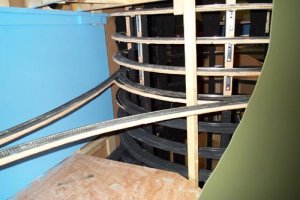Clark, I have built a double track helix (24 and 26" radius). The grade is certainly a consideration. I model the 50's, and do not use dome cars, I measured my tallest equipment and found that I could get by with 2 5/8" clearance. The other major factor is the thickness of the roadbed. I used 3/4" plywood. so my total rise per revolution was 3 3/8" This works out to about 2 1/4% grade. Mine has been in operation for a couple years with no problem. Realize however, the trackwork needs to be perfect the first time, you will not be able to relay it later. I had 16" wide 4' long shelves which I cut into 1/4 of a circle. I used a router to remove 3/8" from the top of one end and the bottom of the other end of each 90 degree piece. These were screwed and glued together. I assembled three pieces, then laid track on them (also ran a buss wire and soldered feeds at this point) when finished with track and wiring on the first three sections, I assembled the next three sections and so on. I used pieces of 1x3 to separate the layers as I went. When complete, I ripped 2x4's in half to get 2x2 and these then had slots cut into them (I set my tablesaw blade at 1/2" and made several cuts side by side to obtain a 3/4" wide slot 1/2" deep) The slots were 2 5/8" apart. I then tapped these into place on the 3/4" roadbed and they maintain my clearance as well as serve as a means to hold the helix in place on my benchwork. I should mention that I am no carpenter and my helix isn't pretty, but it works.
Gary


